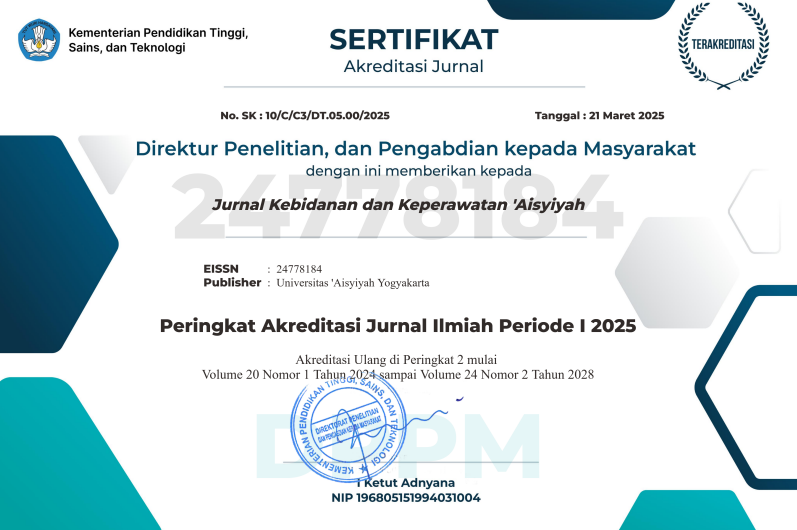Studi Kasus Uji Pra Klinik Perawatan Ulkus Kaki Diabetic Dengan Topikal Hidrokoloid Kunyit
DOI:
https://doi.org/10.31101/jkk.394Abstract views 2371 times
Keywords:
hidrokoloid kunyit, penyembuhan ulkus, ulkus kaki DMAbstract
Downloads
References
Akbik, D., Ghadiri, M., Chrzanowski, W., & Rohanizadeh, R. 2014. Curcumin as a wound healing agent. Life Sciences.116(1). 1–7. https://doi.org/10.1016/j.lfs.2014.08.016
American Diabetes Association. 2015. Standards of medical care in diabetes. Journal of Clinical Case Reports, 38(January).
Chowdhary, S. K. 2015. Topical effect of turmeric in superficial burns. International Journal of Clinical and Experimental Medicine. (May). 198–202.
Dumilah, F. R. 2014. Pengaruh ekstrak rimpang kunyit (Curcuma domestica Val) terhadap bakteri staphylococcus aureus dan escherichia coli secara in vitro. UMS.
Dumville, Deshpande, S., Meara, O. S., & Speak, K. 2013. Hydrocolloid dressings for healing diabetic foot ulcers (Review). Cochrane Library, (8). https://doi.org/10.1002/14651858.CD009099.pub3.www.cochranelibrary.com
Eliana, F. 2015. Penatalaksanaan DM Sesuai Konsensus Perkeni 2015. PB. Perkeni. Jakarta.
Europe wound management. 2015. Guidelines for the assessment & management of wounds. Northamptonshire Healthcare.
F. Aguilar Rebolledo, J. M. T. S. and J. E. de la P. 2011. The pathogenesis of the diabetic foot ulcer : prevention and management. Global Perspective on Diabetic.
Fletcher, J., & Health, P. P. 2005. Wound bed preparation and the TIME principles. Nursing Standard (Royal College of Nursing (Great Britain) : 1987).20(12). 57–65; quiz 66. https://doi.org/10.7748/ns2005.11.20.12.57.c4019
Frykberg, R. G., & Moines, D. 2010. Diabetic foot ulcers : pathogenesis and management. Des Moines, Iowa, 1655–1662.
International Diabetes Federation. 2013. Methods for developing the “ Diabetes Guideline 2013.†International Journal of Diabetes.
Julianto, E. 2015. Efektifitas hidrokoloid kunyit (Curcuma domestika) terhadap proses penyembuhan luka diabetik stadium I pada tikus (Rattus novergitus). Jurnal Husada Mahakam.IV. 18–23.
Kantor Deputi Menegritek. 2013. Kunyit (Curcuma domestica). Majalah Kedokteran Indonesia.
Kementrian Kesehatan RI. 2014. Pusat Data dan Informasi Kementrian Kesehatan RI 2014. https://doi.org/24427659
Maryunani, A. 2013. Perawatan luka modern (Modern wound care) (2nd ed.). Jakarta: InMedia.
Monograph, N. S. 2012. Turmeric (Curcuma longa Linn) and curcumin. Bottom Line Monograph.
Münter, D. C. 2012. Diabetic foot ulcers – prevention and treatment.
Registered Nurses’ Association of Ontario. 2013. Assessment and management of foot ulcers for people with diabetes.
Snyder, M., L. R. 2010. Complementary & Alternative Therapies in Nursing (6th ed). LLC: New York: Springer Publishing Company.
Steevens’, D. 2009. National best practice and evidence based guidelines for wound management. (Health Service Executive, Ed.). Dublin 8 Ireland: Health Service Executive.
Whiting, D.R., Guariguata, L., Weil, C., & S. 2011. Global estimatesof the prevalence of diabetes for 2011 and 2030. IDF Diabetes Atlas.
Widasari, G. 2008. Perawatan Luka Diabetes (2nd ed.). Bogor: Bogor. Wocare Publishing.
Downloads
Published
How to Cite
Issue
Section
License
With the receipt of the article by the Jurnal Kebidanan dan Keperawatan Aisyiyah Editorial Board and the decision to be published, then the copyright regarding the article will be diverted to Jurnal Kebidanan dan Keperawatan Aisyiyah. Universitas 'Aisyiyah Yogyakarta as the publisher of Jurnal Kebidanan dan Keperawatan Aisyiyah hold the copyright regarding all the published articles in this journal.
Jurnal Kebidanan dan Keperawatan Aisyiyah is licensed under a Creative Commons Attribution-ShareAlike 4.0 International License.
















